
|
|
|
Search our site
Check these out    Do you have an entertaining or useful blog or personal website? If you'd like to see it listed here, send the URL to leon@pawneerock.org. AnnouncementsGive us your Pawnee Rock news, and we'll spread the word. |
Too Long in the WindWarning: The following contains opinions and ideas. Some memories may be accurate. -- Leon Unruh September 2006A photo I like: No. 4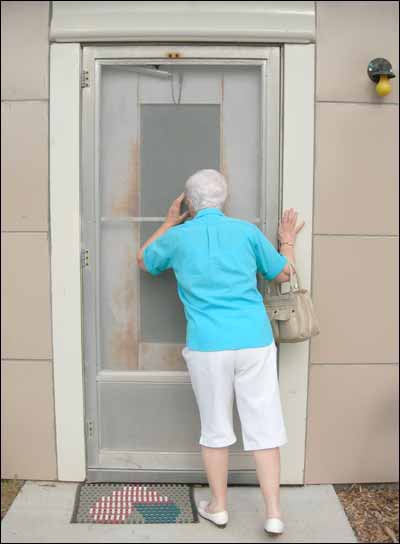
[September 30] The Lustron home, with a frame and exterior made of metal, is a popular feature at the Barton County Historical Museum south of downtown Great Bend. Great Bend has more than a dozen of these homes and considers itself the Lustron capital. (More about the museum.) Football on the horizon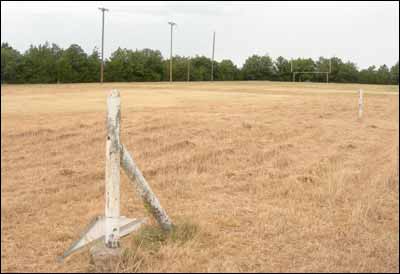
The lights still stand over Pawnee Rock's old 80-yard football field. [September 29] Pawnee Rock was a proud member of the South 50-6 League. Now, how did the league get that name? Did "South" stand for Spread Out Unto The Horizon? Maybe "6" was the original number of teams. But why "50"? On my way from Pawnee Rock to Denver last month, I drove through South 50-6 country: past Rozel and Burdett and Hanston, then north to Ness City and west. I passed south of Bazine, Utica and Healy. Aside from Ness, all those towns were on our football and basketball schedules. That's a lot of driving. It's two hours to Healy, longer if you're in a school bus. I noticed something this time as I slowed down in Hanston -- the openness of the football field. Spaciousness is one of those things that I grew up with and that seemed unremarkable until I spent too many years in big cities and forgot how things should be. The Great Bends and Dodge Cities and Wichita Souths pit their boys against one another in games played before big concrete stands with tall fences to keep all but the paying customers out. But Hanston, like the old Pawnee Rock, like Macksville, like dozens of other towns west of U.S. 281, doesn't keep people out. On Friday night, people are invited in. Come be with us, the big lights say. Be part of the ritual. Admission is taken from people who drive to the game. But look around the field. See any chain-link fences or guards? Anybody can walk up. Fans in these plains towns sit on bleachers bolted to a welded frame, or they stand outside the cable fence that keeps the fans off the coach's back. On rainy nights you might find them in their cars ringing the field, getting out only for popcorn and trips to the bathroom and honking when their team scores. And in six- and eight-man football, that's often. In these towns, the Friday night football game is a community event. Most of the families have a kid wearing a helmet, or holding a pompon, or playing in the band, or their neighbor does. Drive across the plains on Friday evening, and you'll see the hazy glow of football lights rising against the darkness. These are towns where people think their kids -- and the town's traditions -- are worth keeping. We of the South 50-6 League know what it's like to eat popcorn out of a paper bag while we sit on painted bleachers a few rows from the band next to a football field where people drive across the track to park up close. And we don't need a program to know the players. Added later: When in doubt, ask Mom. Anita Byers wrote to say that the name of the South 50-6 League came from the days when U.S. 50 was divided into two parts: 50 North and 50 South. (50 North became our U.S. 56.) Many of the league's teams were to the south in Stafford County, which is split by U.S. 50. As member schools expired or grew too large, the remaining schools had to look to the west for new members. Towns that at one time were members of the league included Pawnee Rock, Byers, Macksville, Radium, Trousdale, Belpre, and Zook. Of those, only Macksville still has a school. A bird in the hand[September 28] A Pawnee Rock fellow walks into the veterinarian's office. He's carrying a large waterbird. "What can I do for you?" the vet asks cheerfully. The man with the bird says nothing. "Yes, sir, can I help you?" the vet says a little more loudly, figuring that maybe the man is hard of hearing. No answer. The vet shouts: "Sir, do you need help?" Still not a word in response. Frustrated and annoyed, the vet yells: "What's wrong with your heron?" That was the first joke I made up for my future wife. Today's her birthday. What, besides ibuprofen, do you give a woman who already has me? Happy Birthday. In the history book[September 27] If you were in school between 1916 and 1930 or so, you might have read about Pawnee Rock in a state-published textbook, "A History of Kansas." 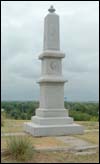
Pawnee Rock is mentioned in two places. Here's one of them, leading off the chapter called Kansas Memorials: "The people of Kansas are proud of the history of their State and desire to preserve it. To that end they have taken steps to save a number of the old landmarks, they have built many monuments, and have gathered and kept many records of the past. "One of the early landmarks was Pawnee Rock on the old Santa Fe Trail, in what is now Barton County. This giant rock standing on the level plain was a noted spot, for the Trail ran near its base, and while it provided a place of rest and safety for many a weary traveler, it also afforded a retreat from which the Indians could dash down upon the traders. In later years much of the rock was torn away for building purposes and this historic old landmark was rapidly disappearing. The Woman's Kansas Day Club resolved to save this historic spot, and secured a deed for the Rock and five acres of ground surrounding it. On Kansas Day, 1909, the women presented this deed to the State. The transfer was made with the condition that the State spend $3000 for improvements. This was done and the preservation of Pawnee Rock is now assured." ("A History of Kansas," by Anna E. Arnold. Topeka: State of Kansas, 1916, pp. 201-202.) In addition to the work of the Woman's Kansas Day Club, the Daughters of the American Revolution traced the trail from Missouri to New Mexico and had granite markers put up along the way. Pawnee Rock's is tucked under the lilac just north of the Rock's entrance. To those who grew up in town, Pawnee Rock State Park has always been a place to have a picnic and take the visiting relatives. I think that nowadays, so far removed from the time of the Santa Fe Trail, we overlook its value because we see it every day (or did until we moved) and think of it as part of our collective back yard. Frankly, it can be hard to comprehend the scope of events that have played out around that red sandstone. We owe a lot to Benjamin P. Unruh, the landowner who gave the Rock to the state, and to the state and national history-minded organizations that took the Rock under their wings and preserved it for us. We should be grateful also to the people who maintain it today. Sometimes it's good to step back and see how much of a treasure others consider our Pawnee Rock to be. It's our part of America's grand adventure. Cherries in the draw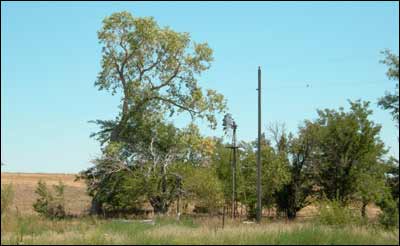
The draw, where the cherry trees grew. [September 26] During my recent visit to Barton County, my cousin Mary honored me by making a cherry pie "like the ones Grandma used to make." Mary warned, "Watch out for the pits." That was a standing joke at Grandma's kitchen table. We picked the cherries ourselves on summer afternoons from trees down in the draw, where the windmill created an oasis between the pasture and the wheatfield, and sometimes not every cherry got pitted. Mary did a fine job in the kitchen. The pie tasted good and was gone in a couple of days (I shared with Dad and Betty). The cherries in Mary's pie came from somewhere new; the draw on the farm no longer has cherry trees among the cottonwoods and honey locusts. Like Grandma and Grandpa, the trees were fruitful for many years and have moved into history. Where we live now, almost all the fruit grows close to the ground: blueberries, raspberries, and so forth. Cherries, peaches, and other stone-bearing fruits find our climate too harsh. Yesterday, I watched my boys sit amid the berry plants on the south face of a mountain, exclaiming over big berries and unexpected clusters of them, and I thought of the fun I had with Mary and Brenda and Cheryl filling Grandma's buckets and basins almost four decades ago. The boys have different fruit and different scenery than I did, but the idea is the same. Every generation loves to fill its own plate, and every new set of kids finds its own happy days in the sun. Motto for our town[September 25] Kansas has had its slogans: Midway USA. America's Breadbasket. Aaaaah, Kansas. Kansas: As Big as You Think. Every big city seems to have an advertising slogan. Wichita, for example, used to call itself the Princess of the Prairie and the Air Capital of the World. And look at all the towns in Barton County that claim to be The Gateway to Cheyenne Bottoms. Well, what about Pawnee Rock? Can we come up with a nifty slogan? We've all seen the town mentioned historically as "the most dangerous place on the Santa Fe Trail," but that hardly seems like the bumper sticker Pawnee Rock wants these days. Does anyone have suggestions? Let's see what we can come up with. I know you're clever people. E-mail your suggestions, and in a week or so I'll post them here. Heavenly music[September 24] The Mennonites sat expectantly, politely, in the pews. I stood behind the wooden rail on the stage, my silver trumpet in my hands. Mom had coached me to smile and speak loudly, but my voice felt strained. "I will play 'There Is a Balm in Gilead,'" I announced, not knowing whether my voice carried to the old folks in the back of the church. But I did know one thing -- they'd hear my trumpet. When it was over, I smiled and was grateful to be done with it. I didn't know whether anybody was pleased with the music. Few smiled back, and nobody clapped. Our church didn't clap. I wasn't the only Pawnee Rock kid who gave command performances. Ida Deckert sang, Susan Schmidt played the flute, and others brought their trombones or piano music. Most of us young members found ourselves in the rotation to provide the entertainment on Sundays when the youth choir didn't sing. Strictly speaking it was worship, rather than entertainment, but I think everyone who performed was less concerned with the hereafter than with getting safely through the here and now. One morning a miracle happened. It was a normal Sunday, a warm day. Families were sitting in their traditional pews. Ours was off on the south side, to the Rev. Gerhard Peters' right. I had a clear view of the sanctuary, which was illuminated by stained-glass windows. Ida was rolling through her soprano solo. It filled the church; she was the best singer in school. When she finished, there was silence. And then, as if she had acted before thinking, Susan started to clap. Sondra Deckert joined her, and of course the rest of the church had to clap too. It was as if a joyful noise was being given back to Ida, and we good Mennonites grinned with naughty pleasure. A moment later, a cloud passed over the congregation. The thought hit all of us: Would we have to clap again next Sunday? A photo I like: No. 3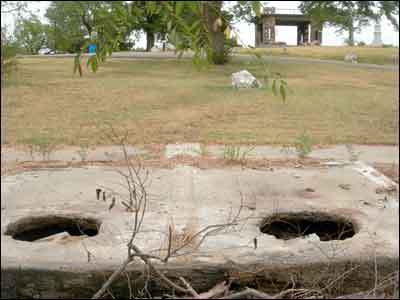
[September 23] This is where Pawnee Rock State Park's visitors went when they had to go, and now it's gone. An outhouse occupied this rectangle of concrete for many years on the west side of the park. I took the photo in August. Friends, sun, cotton, and cattle[September 22] We got a couple of new Friends of Pawnee Rock this week: Bob Wycoff and Pat Croff. They're brother and sister who lived in Pawnee Rock until the 1940s and now live a few hours apart in beautiful Northern California. Other Pawnee Rock-connected people who have signed up are Earl and Janice Schmidt, Marsha (McFann) Bouker, Steve Ross, Julietha Jones, Laramie Unruh Jr., Virgil and Joan Smith, Don Ross, and your host, Leon Unruh. A little more darkness: One neat thing about the solstice is that it flips the world around. Yesterday everybody who lives north of you had a longer day than you did. Tomorrow, everybody north of you will have a shorter day than you will. Cotton farmer: Glenn Mull, who operates the feedlot south of Pawnee Rock, is also getting into cotton farming. There's a story about him and his cotton in today's Great Bend Tribune. I wish I could see this: More than 60 Texas longhorn cattle will be paraded through downtown Ellsworth on Sept. 30. It's part of a very busy week in that cool city. Peg Britton's blog lists the activities. Thanks: This is the 150th entry in Too Long in the Wind. PawneeRock.org was launched in February, and I started writing this column in March. Thank you all for reading it. Also, I appreciate all the contributions to the photo gallery. We now have more than 165 modern and historical Pawnee Rock photographs in our collection. I love to tell the story[September 21] Elva Jean Latas never read "The Sixth Grade Story" by Leon Unruh, or I'd be crumpled up like a candy bar wrapper back by the potted lime tree. "TSGS" was written during free moments in sixth grade. Because I was on the verge of teenagerdom, it was full of complaints about Mrs. Latas and comments about my classmates. Did I understand the world beyond my desk? No. Did I need a way to vent, to say what I wanted to say where nobody would read it? You bet. I haven't seen the book for a few years, and I wonder whether I'd have the guts to read it now. I can foresee cringing at my cursive and my observations. Certainly, I would ache to give it some structure and editing, which is one thing I've gotten good at. I wish I knew then what I know now. It's altogether possible that Mrs. Latas noticed that I was always writing in a notebook with a red-and-white striped cover, and she probably did read my deepest blue-ink thoughts after school let out. Maybe she liked the parts where I said she was a hard teacher. "The Sixth Grade Story" was my third book. The first one was called "The Ghost and the Haunted House" or something like that. It involved a bunch of kids who figured out that someone created a ghost by dropping pills into a pipe; it's the same magic used by engineers of toy locomotives who make smoke rise out of the stack. The dialogue involved a lot of "Golly," "Holy ghost!" and "Zowie," and the punctuation showed an utter misunderstanding of ellipses. The second book . . . well, I have forgotten what it was about. Mom read my stories and laughed at the parts I said were funny. She ignored the little dot I put over every fiftieth word and encouraged me to write more. She had faith that if I wrote and wrote, I'd eventually find something to say. Like a lot of grownups, I toy with the idea of writing a book. A travel book about Alaska? Sure. How about an adventure novel set in the wilds? Or a romance? Well, I'd have to be at least a little romantic for that to be believable, so maybe in my next lifetime. Writing can be hard. Sometimes you have to tell the truth. How book authors can do that day in and day out is beyond me. And they have to worry about plot, too. It was a lot easier in fifth and sixth grades. I wrote just how I wanted to, and I told the story I wanted to. So when our boys compose three-page tales about gerbils and NASCAR and sea otters, I laugh at the funny parts and ask them to write more. Behind the inexperienced dialogue and improbable plots, there's a streak of honesty in their stories. Maybe it's that way for all kids. I wish I knew now what I knew then. Streams of memories for Don Ross[September 20] Don Ross, our energetic supplier of Pawnee Rock photos and lore, had this to say after reading yesterday's report: "I enjoyed your fishing article, and it sure is the truth. It brings back memories of fishing with my dad. In the fall of the year when all the work was done, he would pick me up after school and we would head for the river or Ash Creek or both, where the Ash runs into the river. "If the river was running good, and it usually did back in the '40s, we would fish for channel cat, but we usually had our best luck in Ash Creek fishing for bullheads and occasionally a channel. We always tried to outcatch each other. "Many times dad would say 'Let's go get John Lamb and take him along.' John had plenty of time to fish, and he always had a milk bucket full of worms and was ready to go. He was a very nice old man. "I remember one time my Grandpa Ross, Uncle Dean, and my dad and I went up to the Walnut for a day's fishing. Again we all tried to outcatch each other. I remember to this day Dean had 21, Dad had 20, and my grandpa had 19. They razzed my grandpa all the way home. I was too young to participate in the contest but remember it well. "I wish I could go fishing with my dad again, and I wish I could thank him for being such a good dad." By fishing obsessed[September 19] Charles Jelinek talked incessantly about fishing. 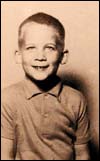 "I'm going fishing with my dad on Saturday," Chuck would tell our Pawnee Rock kindergarten class one week, all week. Later, we heard about "my fishing trip with my dad when we caught lots of fish." Poor Chuck spoke so obsessively about fishing that Mrs. Loving, the nurturer of young spirits, told him several times to change the subject. Those episodes are all I remember of Chuck. He left after that year. Now, as our sons are passing through their various obsessions, it's easy to imagine a kindergarten teacher's life of hearing about clothes, Thomas the Tank Engine, bicycles, and fishing (not that there's anything wrong with fishing). Already this week, I took the boys fishing a couple of times as we rushed to accomplish as much as possible before winter puts a hammerlock on water sports. We fished for trout and salmon at one lake Sunday; Sam caught a young coho on his first cast and that was it for the day. Before long, while I watched the bobbers, the boys were playing under the dock, trying out frog lures, and laughing at a poor squirrel Nik inadvertently startled into dropping its supper of berries into the water. After school on Monday, we hiked to a waterfall then fished for rainbows in a second lake. No fish, but Sam began rocking on a piece of plywood over a mudhole, then put his hands deep into the muck. After he washed them off, I lent him my camera, and I let Nik sit in the Civic and read the owner's manual. All this unfocused activity brought to mind some fishing trips I made with my dad: to Pawnee Creek, to Cheyenne Bottoms, to Walnut Creek, to Gerald Schmidt's stock pond, and to another pond that I think was somewhere near Jesse and Glenda Franklin's house. My attention wandered on those excursions, I suppose, because I remember digging for snails in the mud, finding archaeological surprises in the creekbed, and pulling candy bars out of Dad's tackle box. As I walked the dog late last night, I had an epiphany. All these years, I had been listening to my memory of Chuck Jelinek the wrong way. I had heard "fishing." What I should have heard was "with my dad." Marvin Finger Sr.[September 18] A man I didn't know well but who impressed me a great deal died last week. Marvin Finger Sr. of Rozel passed Friday after a stroke. I first met Marvin in the 1970s when I was a member of the Pawnee Rock 4-H Club. His kids were in the Rozel club, and we all had our county fair in Larned. That's where I met one of his daughters, Patricia, and one of his sons, Stan. I went out with Pat a few times, and I had the pleasure of working with Stan a few years later at the Wichita Eagle, where he is a reporter. The Sept. 17 obituary in the Great Bend Tribune summarizes Marvin Finger's life and his generosity. Read between the lines, and you'll see that Marvin was the kind of guy you'd do your best for, because you would want him to respect you. Drinking that no one saw[September 17] The sound of the pickup engine being gunned down the country road woke me up. In a few minutes, the pickup pulled up to Ash Creek Point; the doors opened and three guys burst out with obscene yells. It was a late summer night, and Rob Bowman and I were camping along the creek, below the bank and out of sight. Peeking out, Rob recognized the boys as kids from Pawnee Rock High, and with some misgivings I joined him as he went to say hello. We were in sixth and seventh grades, or something like that, and callow. The three interlopers were well on their way through a case of Coors. Rob and I turned down their offer of a beer and hung around the edge of their bonfire. It was the price we paid for camping at the Point, where the muddy creek flowed into the Arkansas River. The fishing was good here, but it was also a popular party spot. These thick-chested boys soon announced that they were going to South Hoisington to find a prostitute. Rob and I shrugged and went to our sleeping bags, but after midnight the boys were back with a tale of debauchery. When they woke in the morning it was with red beer. Camping along the river often brought such excitement. High schoolers loved their cases and kegs, and the cottonwoods provided a sense of privacy from parents and police. For a straight-arrow kid like me, it was sometimes frightening to hear the screams and shouts; all I wanted to do was be invisible and be left alone to fish. But alcohol was a big part of high school life. Not in public, of course, because we learned quickly that any adult or under-18 kid who drank in front of certain other adults was going to be branded for life as a lush, never quite shunned but never accepted. So without good role models, we drank among ourselves, as every generation does. Dad told me once about two of his brother's friends who made the mistake of dropping by his parents' house in the years of World War II. "They had red eyes and they fell asleep on the couch," he said. It was that way all through high school, in Pawnee Rock and Macksville. There were the casual and steady beer drinkers who had brothers who were 18 and would buy beer. There were the unhappy pretty girls who laughed as they started the weekend at sundown, with one hand holding an older boyfriend and with the other clutching a bottle of Boone's Farm to their chests. In our universe of repression, it wasn't surprising that so many teens navigated to cheap beer and sloe gin. But I will say this: If there was an advantage to being around heavy, stupid drinking as a youngster, it's that I got to see drunks before I wanted to be one. What I hope I learned was not judgment but understanding. A photo I like: No. 2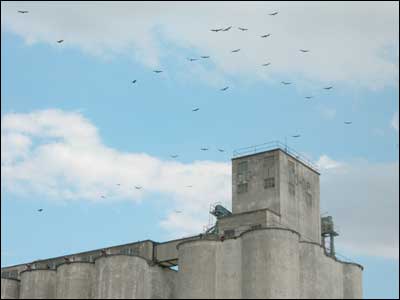
[September 16] These birds -- crows, perhaps -- were riding the updraft created where the south wind hit the elevator in Jetmore. It was the tallest "hill" for miles and miles. There may have been 50 or 60 of the birds hanging there or nearby, nearly motionless in that that August evening sky. Life's a picnic in the park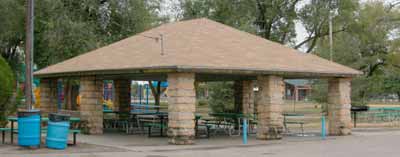
[September 15] They say that youth is wasted on the young. Normally I'd agree, but the young have always been perfectly suited for field trips to Brit Spaugh Park in Great Bend. Our Pawnee Rock Grade School classes loaded up the bus once a year and went to the big limestone shelter west of the Santa Fe locomotive. We spun around on the flat wheel, bounced on the teeter-totter, and scrambled up the Everwear steps and down the big slide. Minimal supervision, a good sack lunch, and new playground equipment made all the difference for us in Mildred Dunavan's and Virginia Fry's classes. And back in those days, going to Great Bend was a big deal. Maybe it still is for a third-grader. This all comes to mind because of a story in Thursday's Great Bend Tribune about how the zoo's old cages are being replaced by pens that are more humane. I think we're all glad for the animals, and we'll be overjoyed if the zoo stinks less than it used to. After our class ate lunch, we walked through the zoo. We kids spent a lot of time flirting and running around like monkeys and chattering birds. But we did pay attention to the animals; I liked the big cats. I'm sure Mrs. Dunavan and the other teachers saw the appropriateness of taking grade schoolers to the zoo. No doubt we lived up to their expectations. When I was in high school and spent my summers in Great Bend, I walked over to the park a couple of times a week. Because of how the park was introduced to us, I always felt comfortable there even when I was alone. I'm sure my sister would say I felt at home because I belonged in the zoo, and maybe she would be right. All well and good[September 14] The first televised episode of the "Adventures of Superman" with George Reeves involved the mole-men, a pack of costumed little people who climbed up the inside of the world's deepest oil well and popped the lid to step into the open air. They meant well but were misunderstood by the human race, which had its knickers twisted by the Cold War and was afraid of anything that was not ordinary. Superman saved the day, of course, by helping everyone work out their anxieties. 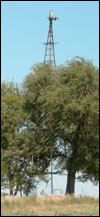
Of all of Superman's adventures, the mole-men were the scariest because it was possible that they existed. We lived in oil country, so mole-men had easy access to us. In my world, the most likely place for them to climb out was not from under an oilfield derrick but from the disused well in my Unruh grandparents' yard. The well had been dug in the first years of the 20th century, and a windmill -- spinning blades atop a tall structure shaped like a derrick -- pulled water out of it. Many years later, after a new well was dug a few yards away and an electric pump was installed, the old well was turned into a trash pit. Things tossed into the well never were seen again. When I helped Grandma in the garden south of the well, I gave the hole and its concrete deck a wide berth. The windmill itself was made of angle iron, held together by nuts and bolts and twisted wire, and it was scary in its own right. Dad dared me once, when I was an adult, to climb the windmill. I got a few steps up the steel ladder before my nerves were as shaky as the windmill. Dad, who must have been 65 or so, started climbing. In a minute, he was at the top, waving as the struts creaked. He used to do it all the time, he said, to maintain the gears. Now I wish I had gone up the ladder, but that time has passed. I'll just have to settle for being the son of Superman. What does Pawnee Rock want?[September 13] Leilani Jones wants your opinion. I wrote a couple of weeks ago about Leilani and her interest in Pawnee Rock and the school. She sent an e-mail Tuesday to be passed along to the people of Pawnee Rock. Please give this a look. Mention it to your friends in town, especially to the city council members, and to anyone else who has an interest in the Pawnee Rock school and city building. Leilani wants very much to hear from you. Like our ancestors did, and like many of us did, she's considering taking a big chance and exploring a different part of the world. To help her dream come true, she's asking what you want. Here's what she wrote: A letter to the citizens of Pawnee RockWe have been considering your school. I have a few questions of you. If we started an arts community and tried to make Pawnee Rock more of a "destination," how many of you would be interested in participating? Would any of you or your children be interested in art or photography classes? Would you have crafts or art pieces of your own that you would want to sell on consignment or in a rented booth? Woodworkers, quilters, potters. Anybody do stained glass? Have you always thought about selling your photography but didn't know where? I've always wanted to belong to a quilting club so that I could learn more about it. Would anyone be interested in it also? Would you come to special music nights? Are any of you musical? If we opened a cafe, what would you want from it to make you want to go to it? What kind of food? What kind of atmosphere? My specialty is desserts and baking. Would you come and purchase that kind of thing? Would there be interest in a bookstore? One of our friends is a dog groomer and wants to open a kennel. A "just like at home" kennel. We love our own dogs and cats. Is there a need for that kind of service? By "just like at home" I mean a place with chairs and couches and comfy beds. A TV. A water area outside. Is the community close? Would "outsiders" be welcome? Would you be interested in a monthly pot luck at the school? A community pot luck. Do you have any ideas of what your community needs? What service you could really use. Maybe a small convenience store. Let me tell you why I ask. We are a group of friends and families. My husband and myself, three of our friends. My daughter and her husband and two children. Possibly some others but these are the core. We would be leaving jobs here and would need to be able to support ourselves and pay our bills. We know that we will have to work in one of the larger towns nearby, but the cafe is my dream and the arts classes and related things are my friends' dream. Are there jobs around there? Or, are things as dire as here in Michigan? I'm not talking about "glamour" jobs. Clerical, metalworker, waitresses? Anything really that wouldn't cause a person to become depressed! lol Feel free to write to me with your thoughts. (Click here to send a note to Leilani.) Thanx for your time. Leilani Jones A toast to Callirhoe involucrata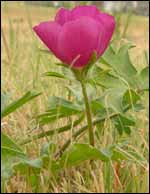
[September 12] The scientific name is Callirhoe involucrata, and you can call it the purple poppy mallow, but I call it the wine cup. Seed catalogs say it's good in sun or light shade and in dry to average weather; well, that's Pawnee Rock in the summer. A few grew in our front yard between the sidewalk and the street -- tall enough to be noticed but low enough to escape the mower. When the plants bloomed, the luscious color stood out well against the grass. Imagine yourself as a seven-year-old lying on the lawn, exploring the plant world. The grass is a bit scratchy but cool. Grape hyacinths are fun to touch, and they have a bit of a sharp taste and a waxy feel. Wine cups, however, are as soft as a summer morning. I found this specimen on the practice field behind the school. At that point I realized I hadn't felt at home until then. Move to Pawnee Rock[September 11] Looking for a quiet, safe place to live? Here are five reasons to move to Pawnee Rock: 1. Location, location, location. Pawnee Rock is close to Larned (8 miles) and Great Bend (12 miles). Notably, Pawnee Rock is on the sunny side of Great Bend -- close to the goods and jobs in oil-company offices, the airport, grocery stores, restaurants, Wal-Mart, theaters, and medical services. 2. Housing. Historic Pawnee Rock has many classic houses built early in the 20th century, with woodwork like you won't find anymore. Check the real estate listings. Prices will be lower here than in the county seats, and Pawnee Rock's streets are a lot broader. Here are some companies that may have Pawnee Rock listings:
3. Opportunity. If you want to start a business, Pawnee Rock is wide open. It has all the utilities, including the Internet, and plenty of room for offices and expansion. There is through-traffic on the highway. There's room in Pawnee Rock activities -- from the churches to the volunteer fire department to coffee at the old depot -- for anyone who wants to be active in the community. Here's a quick look at Pawnee Rock's demographics. 4. Fun. The old school building has a great gym. The Arkansas River is a mere mile and a half away. If you're a cyclist, there are hundreds of miles of paved and unpaved roads. Hunter? Grain fields keep the deer, turkey, pheasants, waterfowl, doves, and quail happy. 5. Familiarity. The folks at the post office will learn your name right away. And when you're known at the post office, you have it made. Big dog, good dog[September 10] The Brights had a dog, named Tip, I think, that was a white and brown beast. I was in grade school, so any large dog was a beast. This collie mix hung out at our sandlot games and sometimes went downtown with the Brights: Toni, Todd, Tracy, and so forth. He was a friendly dog. He was even the father of my dog's pups, nine weeks after an episode in our front yard that frightened me but must have had everybody else in the neighborhood laughing because I was out there naively trying to break things up. One day a few years later a bunch of kids were gathered in the lot next to the New Jerusalem Church, and I rode up on my black bike. Tip dashed in from the left and barked, then jumped on me and nipped my forehead. In the end, it probably meant nothing to the dog. He may not have even been mad at me. I might have just been the moving object that toggled his "chase" switch. Tip didn't leave a scar, but he left fear. When I read Stephen King's book "Cujo," Tip is the dog I thought of, even though I liked Tip. As an adult now, I see and do lots of things that are perfectly normal. So does our large dog, Buddy. But when Buddy gets excited and jumps or when I say something intemperate, who knows what memories it leaves in the minds of our kids and their friends. A happy dog's big bark can be as scary as a bite. Buddy thinks he's human. Like any grownup, I'm just trying to be a good dog. A photo I like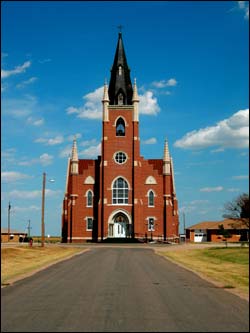
[September 9] I think I will try something new on Saturdays, which I usually take off from writing. I'll call it "Photos I like." These will be photos that don't seem to fit in anywhere else on the site. This photo is of the Catholic Church in Park, Kansas. Park is a Gove County town north of Interstate 70 between Oakley and WaKeeney. It's one of those towns that blend seamlessly with the high plains. Behind the church is a well-kept cemetery. I took the photo this past August on my drive from Denver to Pawnee Rock. River camping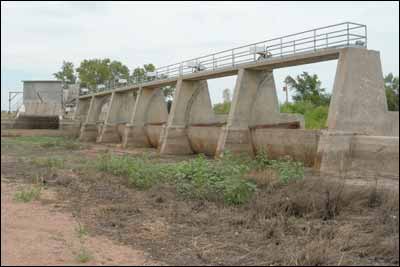
The Dundee Dam and the Arkansas River, August 2006. [September 8] Dean Lakin knew all the songs when he was in junior high. For example, he entertained us for a couple of hours on a Boy Scout hike back from the Dundee Dam by singing about the dawning of the Age of Aquarius. Dean, of course, now is a mechanical engineer contractor and knows all about being the bringer of water. I wish the same could still be same for the Arkansas River. Although our Scout troop 444 went camping a few times near Fort Larned, Lake Wilson, and Camp Kanza (along the Ninnescah River), we spent all our local camping time at the Arkansas River. Much of that was at the Dundee Dam, which backed up a lake two or three feet deep and a hundred feet wide. Some of that water was diverted toward Cheyenne Bottoms, and the rest flowed over a spillway or under a steel gate, headed northeast to Great Bend and then southeast to Tulsa. Our troop's favorite camping spot was upriver from the dam, near where the little dirt road worked its way out of the trees, brush, and poison ivy and dragged along the edge of the farmland. A dirt berm, an effort at flood control, separated the campsite from the water itself and provided privacy. We found lots of evidence that beer drinkers, handgun shooters, and couples who were "parking here for just a few minutes" had enjoyed the seclusion too. Being innocent teenage boys, we fished, threw rocks, shot BBs at floating cans, and swam. We listened to the water as it swept against the sand and roots, and we saw deer come down to the stream with their fawns. Over the years, all our camping trips involved river water or lake water. I suppose that's only natural, living as we did in the Great American Desert. Now the river itself looks like part of the desert. If the drought keeps up, where will kids meet the moist world? Who will bring the water? I can't go home again, but that's OK[September 7] This last trip of mine to Pawnee Rock, in August, was the first time in my life that I came home to Pawnee Rock and didn't have a home to go to. The family house, of course, was sold last fall and someone else lives there now. It struck me this week how much I didn't miss going there. I wonder whether that's because I've let go of the place or because I'm in denial. I'm as complicit as the next person -- I had few ounces of steak for lunch yesterday -- so I can't criticize too harshly. But, my goodness, I don't know how people live downwind from the Ward Feed Yard just southeast of Larned. Early in my visit I drove over to Larned against the setting sun and was puzzled by the dust storm. As I passed the old Grange hall, it hit me: dust kicked up by 25,000 head of cattle walking in their droppings. It's not just Ward Feed Yard, of course. There are lots of cow factories in Kansas and other states, and a lot of us do like our hamburger. And in the south, there are chicken ranches cranking out ammonia by the lungful. And on the coasts, canneries with their gut-wrenching odors. The Mull feedyard south of Pawnee Rock was always a good neighbor, in my memory, other than it smelling like a feedyard. Smells like money, doesn't it? Jobs and food. Now, you could put me next to the alfalfa plant in Larned, and I'd be as happy as a bull in a pasture. I love the smell of alfalfa drying in the oven.
My sister and brother-in-law, Cheryl and Dave, had me over to their place, and we all went to tour the White house. We walked a well-trod path. Presidents and big-name politicians came by early in the 20th century, partly because Emporia was an important city on the railroad and because White was an important Progressive Republican, when that was possible. On the outside, the house looks like many other prairie-town mansions, except that it's made of red sandstone. Inside, there is woodwork and architecture that looks like Frank Lloyd Wright was there, and the rooms have a simple elegance that surpasses the humble homes collected by county historical museums. We had the added advantage of having both a tour guide who grew up across the street and Roger Heineken, who has made himself an expert on all things about White and his family. His knowledge impressed me, and I have three copies of "The Autobiography of William Allen White." Where the grizzly roams[September 6] When I was a fourth-grader in Pawnee Rock, we voted for our favorite book in the William Allen White Children's Book Awards. I cast my ballot for "The Grizzly." "The Grizzly" is a story about trust between a lad and his dad, who are on a salmon-fishing trip in (what seems to be) Alaska. A grizzly mauls the dad and terrorizes the son, but the son finds out that he is much stronger than he or his dad thought. "The Grizzly" won the WAW award that year. Just a year or so ago I found a copy of it in a used-book store, and I have kept it in the bottom of my dresser drawer ever since. Aside from the fact that it reminds me of my class and Mrs. Fry, I don't want to lose something that for 40 years has been an icon of coming-of-age adventure. Not so coincidentally, third-grader Nik and I have been reading "Hatchet," by Gary Paulsen. It's about a 13-year-old who survives a plane crash in the Canadian woods and lives because he uses his wits and his only tool, a hatchet. Last Monday I took Sam and Nik out to the state park up the Eagle River valley, partly to have fun hiking in the forest and partly for a serious purpose. My wife and I are home-schooling the boys, and the class I get to teach this year is one I am creating about GPS and maps. It's a class that could be taught in central Kansas; we happen to have the pleasure of doing it in grizzly country. On our stroll around a rainy eight-mile loop, we marked our maps as we went: bridges, signposts, cliffs, boulder-strewn hollows. Next to Dew Lake, we built a fire using birch bark, spruce twigs, and magnesium shavings ignited by sparks from my knife scraped against a piece of metal. We compared landforms with the map and tested our compasses and the GPS unit. We found and ate raspberries, high-bush cranberries, currants, watermelon berries, and rose hips. This was a GPS/map class, but it was also a character-building class. Nik made himself the line leader, and we talked about how it was the responsibility of the leader to listen and watch for danger. With every expedition we make comes a quiz: What would you do if . . . Dad breaks his leg? A bear comes out of the willows? We get lost? Youngsters don't come by this knowledge at birth; sometimes the questions have to be given to them before they can work out the answers. And if Dad gets bitten by a bear, he wants the boys to have already thought about what to do. Our route took us through bear country along the Eagle River. We saw black-bear scat in the upper reaches, and in the lower miles we walked along a series of beaver ponds where grizzlies feed on salmon. Because we made plenty of noise and there were three of us, the chances of meeting an aggressive bear were quite slim. Some people prefer to tote a shotgun and others go unarmed, but on these trails I feel safe carrying a can of bear spray. It's a pepper-based spray that's a lot like Mace. The range is about 20 feet, and the can is as large as a one-liter bottle. In other words, it's fairly hefty and dangerous enough that it comes with a thumb-operated trigger protected by a safety. As much as I wanted to carry the spray myself, the boys felt better if they held it. They each wanted to be able to protect us. Nik took the duty quite seriously. I had mixed feelings watching my 8-year-old bound down a root-crossed rocky trail, holding a very serious pressurized can in two hands. Pride? Trepidation? Humor? Mostly pride, I think. I was glad to see him take responsibility and have a plan thought out. He felt -- he knew -- he could keep us safe. I am inclined to do all this, I have to believe, because of a paperback I read four decades ago in Pawnee Rock. William Allen White's legacy may be in newspapers and politics, but a Kansas literature contest in his name has been just as valuable to me. Green light, white light[September 5] One of my favorite night sights is an airport beacon -- the revolving green and white lights that let pilots know that there in the implacable darkness of the Kansas prairies is a safe place to touch down. The beacons have always been a part of my Pawnee Rock sense of place. Pawnee Rock didn't have an airport, of course, but any evening or nighttime travel involving Larned or Great Bend always passed those cities' municipal airports. A kid like me, riding in the backseat of his family's sedan, could get transfixed by the beacon: the sweep of the lights, the regular timing, the mysterious big machinery that makes it run. By day, the lights looked like little more than a box on a steel tower. At night, they were bigger than life. Yet for all their reassuring muscle, they become part of the scenery as one ages. When I was in the Argonne Rebels, practice ended at 10 p.m. or so, and we'd get our icy drinks at the 7-Eleven near the Great Bend High School athletic field and drive home to Pawnee Rock in the dark. Usually, Dwight Dirks drove, and his sister, Laura, and Andrew Stimatze and I would be packed into his blue Barracuda. As we approached Dundee one night, white light erupted in the sky in front of us. UFO! we yelled, and Dwight slammed on the brake and then the gas. Silly us. Although we weren't 100 percent sure, we eventually figured out that the UFO had been a plane turning on its headlight before making its approach to the Great Bend airport a mile away. Sometimes it's easy to overlook the airports, especially the lightly used ones in central Kansas. But they won't let us forget they're there. The airports always leave the lights on -- beacons that search the night sky for lost souls. Labor Day[September 4] On Sunday I drove past a church and watched two kids playing in the side yard. A girl of about fifth grade faced a 3-year-old boy. She wore a pink dress, white sweater, white socks and black strap shoes. He wore a gray sweatsuit and sneakers. They were playing a simple game that could be called "match my jump." She would jump her feet apart, and he would follow. She would bring her feet together, and he would follow intently. This went on for almost the whole traffic light -- but one time she paused, and the boy jumped first and she followed. His smile could have lit the church. A few blocks away, another preschooler was learning to ride her bike. Adorned in pink pants and a bulbous helmet, she rolled down the sidewalk, her training wheels chattering. Her dad walked behind, attentive and smiling like people do when they're just happy about life. And it occurred to me how good Labor Day weekend is. For kids, it's a pause after getting started in school -- a weekend to say goodbye to summer and collect one's spirit before diving into books and sports. For adults, it's one last chance to really enjoy the kids before they're lost to school. The next holiday for most adults will be Thanksgiving, with all its obligations and relatives and Christmas shopping. Labor Day is the last pure holiday. And during the three-day weekend, Sunday is the best day, the "free" day. Saturday is for recovering from work, for doing chores. Monday is for the public celebrations and politicians' speeches and gearing back down to work. Of course, now that it is Monday, we'll all do our best to enjoy Labor Day. When you're in Dillon's or the gas station or the restaurant on the way to the Hoisington parade today, hand out some smiles. Help the working stiffs enjoy the holiday too. As a newspaper editor who has worked his share of nights, weekends, and holidays, I guarantee they'll appreciate it. St. John: Haven't been to St. John lately? Refresh your memory with photos on Flyoverpeople.net. Maybe you'll want to stop in for a bite on your trip to the state fair. It's just a few miles south of the Fourth Street intersection on U.S. 281. Jayhawks: The report said the University of Kansas sold 28,000 season tickets for this football season. Do people simply have too much money? After warming up with K-State's traditional schedule (Northwestern State, Louisiana-Monroe, Toledo, and South Florida), will the Jayhawks be able to beat Nebraska for the second year in a row? Well, if it doesn't work out, basketball season starts Nov. 11. Hands-on experiments[September 3] In the science room of the old Pawnee Rock school, one lab bench remains. It's wooden, with a black counter about waist high. It's set up for bunsen burners. Imagine: They let us kids use natural gas. Science, of course, is a discipline of exploration and safety. In our curiosity, we sniffed formaldehyde, which is nothing if not toxic. We rolled little balls of mercury around with our fingers. Who knows how much of it splashed onto the floor or into our clothes or got stuffed into our nasal cavities. The most unforgettable moment in my general science class involved a sophomore named Clifford Riddle. Clifford was a motorhead; he knew cars inside out and couldn't pass up a piece of machinery. When Clifford walked into class one day and picked a sparkplug condenser up off a table, it didn't occur to him that Mr. Hadley might have charged it. With his two hands, Clifford unintentionally completed the circuit, which made him shout a very bad word. He was jumpy the rest of the hour, and I don't think he -- or any of us -- took electrical parts for granted ever again. Most boys played around with machinery, from cars to bikes, and washed greasy parts in gasoline. Until the early 1970s, that was leaded gasoline, which is double poison from the get-go. I have an idea how much gasoline I threw on the ground; some yards probably qualify for Superfund cleanups. Why did it take so long for gas companies to stop selling leaded gas, anyway? Some families made their own lead fishing weights. They melted an ingot of lead in the kitchen or backyard. Then, with the kids hovering over the vapors, the dad poured the lead into molds. I'm like anyone else -- I enjoyed rolling a brand-new lead sinker around in my hands, and I've crimped many a split-shot with my teeth. I personally don't know anyone who ate paint chips. But our houses had lead paint, at least through the 1960s. For people who painted, the risk was always there, and it was simply a part of life. One time Dad spray-painted his pickup maroon in the old Pawnee Rock Herald building -- the garage-like stone building west of the post office. He shut off his compressor and removed his mask. Waving his sprayer, he gestured at the truck. "Son, don't ever do this," he said. Before he went back to spraying, he spat dark red on a rag. Lots of people were full of self-righteous fury when seat belts were introduced. Good heavens. In those days of cars without crumple zones or air bags, using a seat belt was about the only hope we had for surviving a collision. We had a lot of fun in our hands-on lfe. I'm just glad we were able to get out of a lot of what we got into. New address: In the Friends of Pawnee Rock page, please note that Don Ross, who has accelerated himself to high-speed service, has a new address. Wrong school: I misidentified a recent photo on the home page. The wooden country school I called PS 48 was really Prairie Home School, which sat three miles west of the state park. Our wonderful community
Brickwork on the old drugstore. [September 1] I got a very nice note Thursday from a Michigan woman named Leilani. She's a fan of our hometown. "I saw your school for sale on ebay and linked to your website. I have been enjoying it for the last hour. The memories and photos are fascinating. Such a history," Leilani wrote. She's absolutely right. Pawnee Rock does have a great history. From the prehistoric days, then from when the town was settled in 1872, it has been a strong place. Having the coolest name in Kansas doesn't hurt, either. "I have always been drawn to these schools for sale in the heart of our country," Leilani continued. "Yours is exceptional. If I had the money I would be there in a heartbeat. What a wonderful little community to live in. You need the cafe that I would open. With a state park in town it's surprising that you don't have at least one 'touristy' thing for them." Leilani raises a good point about the "touristy" thing. I know Patty Lee is interested in having more of an arts community in Pawnee Rock, and the Pawnee Rockin' Days has been a good way to draw people. Dean Lakin has a serious interest in the town's history and a real understanding of buildings; pump him for ideas. Maybe an annual 50- or 100-mile bike ride, based in Pawnee Rock, could be part of the answer. Pawnee Rock -- a town with beautiful old homes and buildings and trees -- might be able to attract more people (and their money). One or two "touristy" businesses, perhaps a wildly promoted art gallery or cafe, might provide enough momentum to push our town along. The answer, of course, isn't just tourists. It's in keeping Pawnee Rock a healthy, industrious home on the prairie. Big ideas and big dreams are a good start. If they come with fresh faces, that's good too. It is nice to see Pawnee Rock as others see it -- a city of possibilities. Thanks, Leilani. August | July | June | May | April | March Copyright 2006 Leon Unruh |
Sell itAdvertise here to an audience that's already interested in Pawnee Rock: Or tell someone happy birthday. Advertise on PawneeRock.org. |
|
|
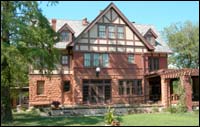 One house I did get to visit on my trip was Red Rocks,
One house I did get to visit on my trip was Red Rocks,